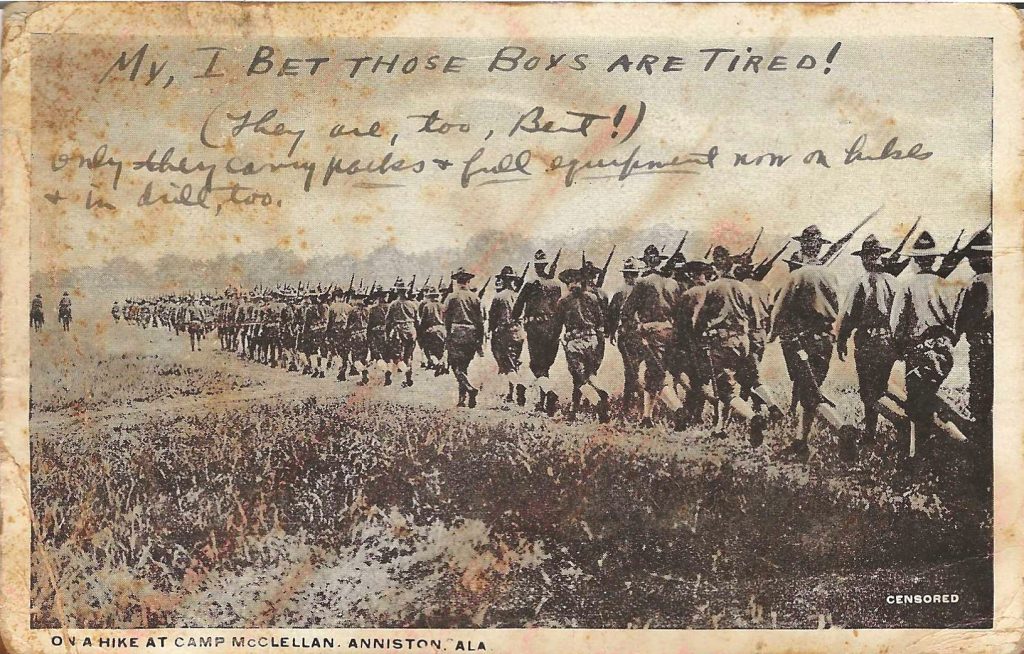Editor’s Staff
Some Goings On at Camp McClellan
This weary old postcard was found in a box of old letters, greeting cards, store coupons, business cards, and random correspondence in a Bridgeton, New Jersey attic. There was even an old “electric light” bill, marked paid-in-full, dated May 1923 for $2.87. The card is truly a relic from a grandmother’s attic.

There is nothing about the discovery of the card that would shed light on any of its aspects. The image/picture, message, postmark, and address are all mysterious elements in a good story. And, so is the location and subject of the card – a hiking exercise at old Camp McClellan, near Anniston, Alabama.
It is always our goal here at Postcard History to present historical tales with reasonable conclusions and when possible happy endings. However, no such circumstance should be assumed in this case.
Camp McClellan
was established in the Choccolocco Foothills of the Appalachian Mountains, in northeast Alabama by the War Department on July 18, 1917, and named it in honor of Major General George B. McClellan, who commanded the Union Army during the Civil War. The camp was one of over thirty facilities formed to train men for service in the American Expeditionary Forces to be sent to Europe to fight in World War I.
The image appears to be an unposed photograph of what maybe hundreds of men on a hike down a dirt road. It is impossible to set an orientation, but with the hills in the background, we could assume that the hike was heading south. The photo is clearly marked: Censored.
The handwritten message above the picture reads:
My, I Bet Those Boys are Tired!
To which someone else has added:
(They are, too, Bert!) only they carry packs & full equipment now on hikes & in drills, too.
Camp McClellen’s backstory
was nearly identical to the other mobilization bases. The commanding officers were appointed, and they relied on fast construction teams to build wooden structures to serve as headquarters, mess halls, latrines, and showers, not to mention whole villages of wooden-floored tents for housing the troops. Throughout the construction phase nearly 1,500 buildings were constructed.
The first troops arrived in late August 1917; by October there were more than 27,000 men from units in New Jersey, Virginia, Maryland, Delaware, and the District of Columbia training at the camp under the 29th Infantry Division, commanded by Major General Charles G. Morton. Other troops included the 1st Separate Negro Company of Maryland, the 6th Division, the 157th Depot Brigade, the 11th and 12th Training Battalions, and the 1st, 2nd, and 3rd Development Regiments.
The war ended less than two years later, but the camp remained until after World War II and continued service until the base was closed in 1999.
The Postmark
is the standard of the era, it reads:
ANNISTON, ALA
MAR 4 10AM 1918
MCCLELLAN BRANCH
The Address
is distorted, but perhaps intended to read:
xxx Bert Stanger
Xxx xxmberland Trust Bldg
Bridgeton, N. J.
The Sender’s ID
is partially distorted, but what is visible reads:
# Xar 18
114th Inf
Xxxx XcCellelen, Ala.
The Message
reads:
Dear Bert,
Very glad indeed to hear from you.
Will write you a letter soon.
Am kept on the jump nowadays.
I have been transferred from Co.
F to Co. M & now again to Supply Co.
Am well satisfied with Camp McC—–
It has my approval, so the war can proceed.
Hope you & the family are well & happy.
Les
In Summary,
Stanger is not a common name in Bridgeton, New Jersey, but there are at least three families with that name in the county. If we assume that Les is mailing the card to a parent, brother, or cousin, we are mistaken for in the early years of the 20th century there was no one with Bert as a given name.
There once was a bank in Bridgeton on the corner of two main highways, but it was never known as the Cumberland Trust.
So, there are no conclusions to be drawn, the sender is not identified, and the addressee is still a mystery.
Sometimes there are no answers to the questions we ask. This has been one of them.
That does rather accurately capture the level of success that a majority of my postcard investigations achieve. It’s a nice card and message, whatever the context might have been.
A dollar bought as much in 1923 as $17.59 does today, so the $2.83 light bill corresponds to a charge of about fifty 2023 dollars.
My friend, Matt Corey, asked me to give this mystery a try, and my research shows the Stanger family had quite a presence in the Bridgeton/Glassboro, (Cumberland and Gloucester Counties) in New Jersey area in that era. I believe the correspondents were family friends and could have been: Francis Albert “Bert” Stanger, Jr. 1887-1969. He was a Lawyer and Judge in the Cumberland County area, and is buried in the Cedar Hill Cemetery in Cedarville, Cumberland Co., NJ And Joseph Leslie “Les” Paulin 1893-1918. This Les died Oct 31, 1918, shortly after this postcard was sent. He died of the… Read more »
Just imagine those. heavy (perhaps wool) uniforms, in hot, humid, Alabama. Thanks for the work and discovery that came from this postcard. wow.